It was a page out the Arabic folklore,?One thousand and One Nights, a narrative by Scheherazade describing the opulent yet traditional abode of Sultan Shahriyar. The faint red light emanating from the traditional Lebanese chandeliers, the beats of the durbakke (tabla) in sync with the unique intonation of the oud (lute)?and the fruity fragrance of shisha, transcended all boundaries; we knew we had landed at the foothills of Beruit, albeit in downtown Kuala Lumpur. Our gracious host, Ralph Zeidan, Marketing Director at Al-Amar, greeted us with traditional Lebanese hospitality at the entrance.

Interior & Terrace of Al-Amar
Absorbing the splendor of the ambiance, Ralph gave us a tour of the restaurant before we sat down. In true Lebanese style, the thing first thing that catches the eye, is the large bread oven and shawarma grills, built in front of the entrance. Fresh bread is baked there to keep up with the free flow of traditional Lebanese flat bread throughout the night. It is the perfect invitation for hungry epicures, the emanating aroma from the oven and the grills.
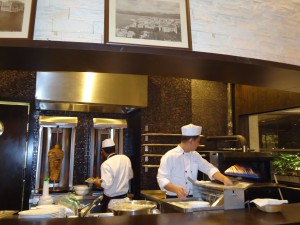
Shawarma Grill and Bread Oven
The surrounding walls and niches are a shrine to their heritage and success. Certificates of excellence and trophies catapulting Al-Amar to the best Lebanese restaurant in Kuala Lumpur accessorized the walls along with pictures and relics defining the history of Lebanon. According to Ralph, the idea is to change perceptions about Lebanese food and imbibe a sense of reality among their customers. From start to finish, Al-Amar promises a true Lebanese experience; a vow which they fulfill from the time you enter the restaurant till the time you say ?ma-salaama? (goodbye). You can opt to sit on their terrace, overlooking the busy Bintang Walk soaking in the balmy Kuala Lumpur air, or in the more formal set-up indoors.
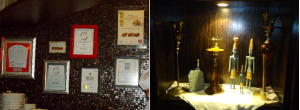
Accolades won by Al-Amar
As we sat on our table, we were joined by Ralph?s colleague, Roger, Head of Operations for Al-Amar. An bio-engineer by profession, Roger joined Al-Amar due to his love of food. His knowledge about food and its processes far?superseded?any F&B professional I had met. Stories from their childhood in Lebanon, their culture and traditions, made it a wholesome experience. According to them, traditional Lebanese dinners go late into the night, long meals accompanied by drinks and shisha. Hence, we followed the same tradition. Leaving the ordering to Ralph, we started off with drinks. Keeping in touch with their roots, the wine menu consisted of Lebanese wines. Roger informed us that they also served Lebanese beer, but due to its overwhelming demand, it was currently out of stock. Ralph ordered Lebanese red wine, Hochar P?re et Fils,?from the famous vineyards of Chateau Musar in Beqaa Valley, Lebanon, for the table. It was a heady blend of Syrah and Cabernet Sauvignion grapes. A perfect accompaniment to full-bodied flavors of Lebanese food.
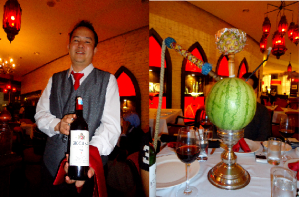
Lebanese Wine and VIP Shisha
Next on the list was Shisha, a water pipe contraption used for smoking tobacco, these days the trend is smoking flavored tobacco. The actual water pipe is glass based, but Al-Amar excelled itself in creating a VIP Shisha, instead of a glass base, they used an empty watermelon shell and replaced the metal tray for holding the tobacco with a pineapple shell. Even though I do not smoke shisha, ordering this piece of art was a must and its grape and mint flavors were thoroughly enjoyed my husband and Ralph. VIP Shisha can only be made by a select few in the restaurant. Whoever makes this type of shisha has to be a professional, a theme consistent with the underlying principles of the restaurant. It is a symbol of life in Lebanon, to smoke away the stress of the day while relaxing with friends and good company.
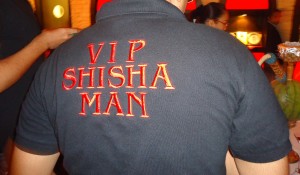
VIP Shisha Man
As the night progressed along with the casual conversations across the table, mezze platters (tapas style appetizers) made their way to our table, which had to be changed as the amount of mezzes outwitted the size of our table. It was the perfect selection of mezzes, each dish defined the cuisine of Lebanon. As Ralph put it very rightly so, the way to test the authenticity of any Lebanese restaurant, is through their Hummous. Since I had tried it before at Al-Amar Express, I knew it would be a true representation of their country. The reason for that, as Roger explained, was it was 100% authentic Lebanese. The chickpeas, tahini and olive oil that created this masterpiece were all imported from Lebanon. The smoky flavors of the Moutabbal (eggplant dip) and the earthy taste of the Labaneh(yoghurt dip) with lemon and garlic were a pleasure to eat with the freshly baked flat bread. At first I tried a little bit of everything, but as time progressed it became difficult to put the bread down and ignore the signals emanating from my stomach. The Tabbouleh (parsley and mint salad) was the perfect blend of herbs and spices, the Spinach Fattayer (samosa) was crisp on the outside and flavorful from the inside, the Batata Harra (spicy potatoes) was subtle yet aromatic, the Wara Enab (stuffed vine leaves) was juicy?and the Kibbeh and Falafel (chickpea patties) were cooked to perfection, moist on the inside and crisp on the outside. One more thing that Al-Amar deserves a pat on the back is how they process their lamb meat. In most restaurants around the world, the lamb sambosak exudes a faint smell of the meat, and it is for this very reason I ate it one bite at a time. At no point did I experience that smell, and my husband who is a fussy eater said the same thing to me later on in the night. If I had to pick, even though it would be a tough choice, my favorite among the mezzes was Samkeh Harra, grilled pieces of fish seasoned with lemon and cilantro strewn across a spicy tomato sauce. The fish melted as soon as it touched your palate, and all I was left with was a burst of flavors. We ate like true Lebanese folk, lots of Mezze, lots of bread and even more conversation.
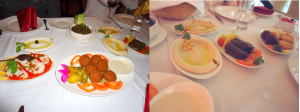
Hot and Cold Mezze
Our dining experience was enhanced by the live singing of a band called Zain (ironically sharing the same name as my husband, which garnered a great laugh at out table), and an exuberant belly dancer who showed off her skills at each table in the restaurant, shaking her hips to the beat of popular Lebanese songs sung by Mohammad. Loud music, excitable clapping,dancing hooting made it an electric atmosphere for a Saturday night (You too could strut your stuff, if you so desired, or learn a thing or two about the art of belly dancing). It was 10:30 pm and the tables were full of an eclectic mix of regular customers who enjoy a piece of Lebanon in Kuala Lumpur. The whole experience transcended boundaries; the food, drinks, shisha, music and belly dancing transported us to a cafe in?Beirut, instead of dining in a mall in the Far East.
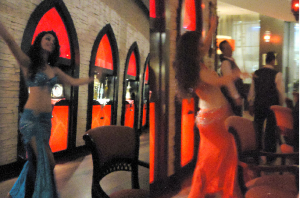
Belly Dancer at Al-Amar
Our appetite was full with the brilliant food, conversation and atmosphere, but alas there was more. The main course comprised of a Mixed Grill platter, which included Shish Taouk (boneless pieces of chicken marinated in lemon, cilantro and sumac), boneless pieces of marinated beef tenderloin and six different types of Kofta (flat cakes of minced meat and spices, charcoaled on skewers). All this served with Toum (traditional garlic sauce), which after many pleas I was given the recipe by Roger. Each piece of meat was juicy, perfectly spiced, exuding aroma and a few bites and it was gone. There was for once, no battle with the meat. Served with two types of Arabic rice, it was a pleasure eating the main course even though the gates of our stomach were officially closed.
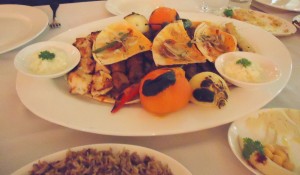
Mixed Grill Platter
Called the ?best friend of the grills? by Roger, the meat platter had to be eaten with a glass of Arak. Considered as a traditional Lebanese alcoholic beverage, Arak is an alcoholic liqeur made from unsweetened anise seeds. A colorless liquid that takes on a milky white shade when mixed with water. Caution, drink one sip at a time, it is highly potent. But then again, that should not stop you from enjoying yourself.
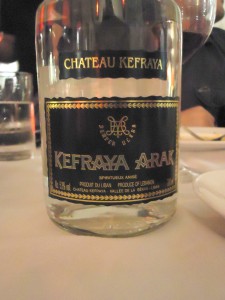
Arak - Anise seed liquer
After our main course, I thought now I could sit back and enjoy the music and dancing and not worry about more food. Our hosts had other plans. Round three; desserts, baklava and a fruit platter. Traditional Lebanese sweets called Baklava are popular throughout the Middle East. Small desserts made from layers of filo pastry and stuffed with pistachios, almonds or walnuts. Each time I look at a baklava it conjures up a very sugary taste on my palate, which is too sweet for my liking. Normally I would just take a bite and ask someone else to finish the rest due to the overpowering sugar syrup. This time after being coaxed by Roger to just try a little bit, I ended up devouring at least 3 pieces (then again who was counting). Ralph had said they had toned the sweetness down to adhere to Malaysian taste buds, but for me it was like someone had finally listened to my complaints about the excessive sweetness of the baklava, albeit telepathically.

Baklava and Fruit Platter
What started off as a restaurant venture in 2008 has bloomed into a full fledged F&B business in just a few years. They have opened up a concept cafe Al-Amar Express (and plan to open a few more in different areas of Kuala Lumpur) and run a successful catering business, with parties hosted for Gucci and Tiffany & Co among others. This is why the have resorted to cooking all their food in a central kitchen which is then delivered to their restaurants for final prep and presentation before being served. The idea behind a central kitchen is to maintain consistency and quality throughout their restaurants.
4 hours just seemed to fly by. The camaraderie and the sharing the passion for food factored in. It seemed as if I had reconnected with some old friends over a great meal, rather than meeting strangers for a review. That in itself is proof of the true hospitality of Lebanon. A restaurant can only be successful if it is a true representation of its cuisine and its people are passionate about their food and culture. Al-Amar Fine Dining exemplifies this theory. Experience traditional Lebanese hospitality, bask in the glory of Lebanese history and culture and feast on gourmet Lebanese cuisine thousands of miles away from Lebanon in Al-Amar Fine Dining, Kuala Lumpur.
Special Nights at Al-Amar:
Friday: Live In-House Band
Saturday: Live In-House Band plus Belly Dancing
rick neuheisel andrea bocelli john hughes panasonic lumix dmc lx5 ucla football deliverance pentatonix
No comments:
Post a Comment